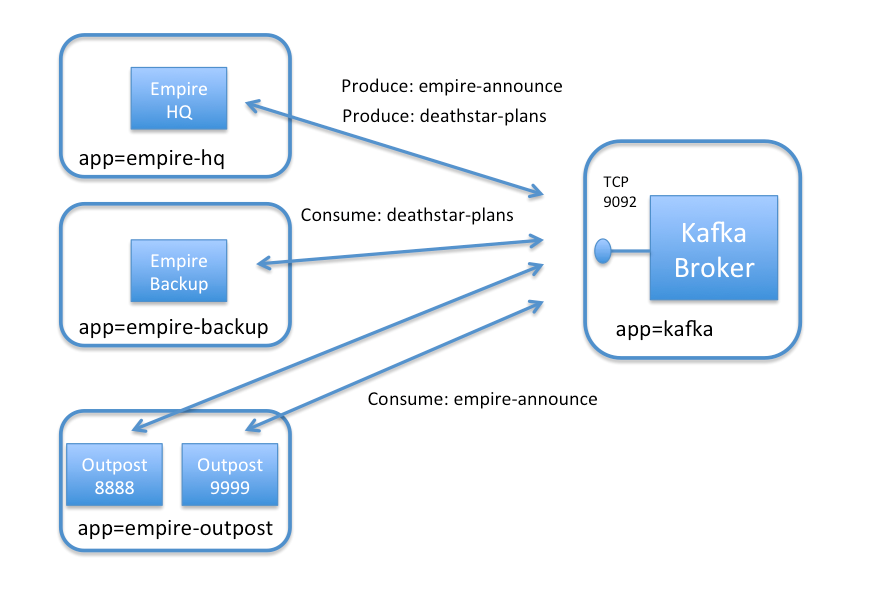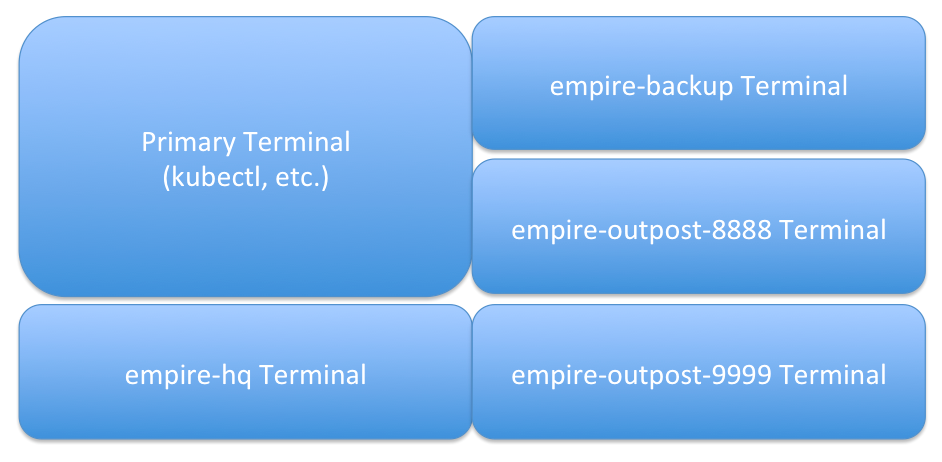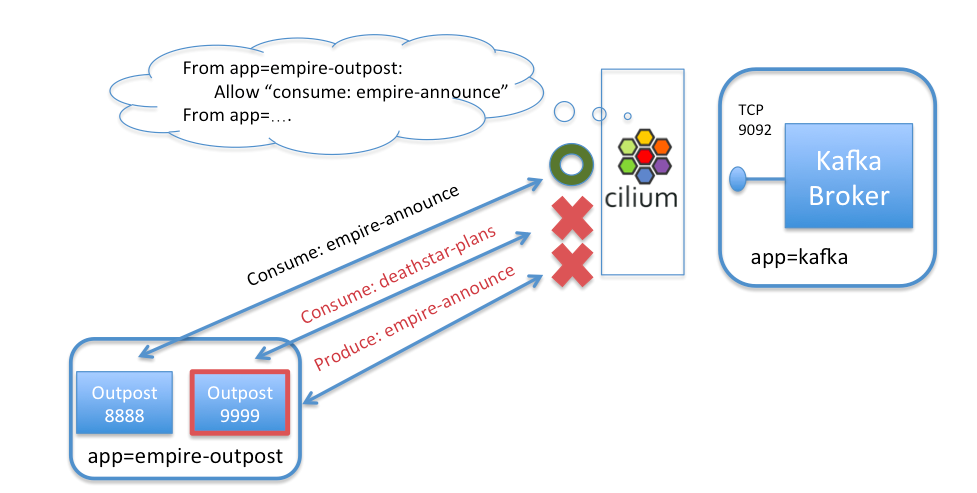Securing a Kafka Cluster
This document serves as an introduction to using Cilium to enforce Kafka-aware security policies. It is a detailed walk-through of getting a single-node Cilium environment running on your machine. It is designed to take 15-30 minutes.
If you haven’t read the Introduction to Cilium & Hubble yet, we’d encourage you to do that first.
The best way to get help if you get stuck is to ask a question on Cilium Slack. With Cilium contributors across the globe, there is almost always someone available to help.
Setup Cilium
If you have not set up Cilium yet, follow the guide Cilium Quick Installation for instructions on how to quickly bootstrap a Kubernetes cluster and install Cilium. If in doubt, pick the minikube route, you will be good to go in less than 5 minutes.
Deploy the Demo Application
Now that we have Cilium deployed and kube-dns operating correctly we can
deploy our demo Kafka application. Since our first demo of Cilium + HTTP-aware security
policies was Star Wars-themed we decided to do the same for Kafka. While the
HTTP-aware Cilium Star Wars demo
showed how the Galactic Empire used HTTP-aware security policies to protect the Death Star from the
Rebel Alliance, this Kafka demo shows how the lack of Kafka-aware security policies allowed the
Rebels to steal the Death Star plans in the first place.
Kafka is a powerful platform for passing datastreams between different components of an application. A cluster of “Kafka brokers” connect nodes that “produce” data into a data stream, or “consume” data from a datastream. Kafka refers to each datastream as a “topic”. Because scalable and highly-available Kafka clusters are non-trivial to run, the same cluster of Kafka brokers often handles many different topics at once (read this Introduction to Kafka for more background).
In our simple example, the Empire uses a Kafka cluster to handle two different topics:
empire-announce : Used to broadcast announcements to sites spread across the galaxy
deathstar-plans : Used by a small group of sites coordinating on building the ultimate battlestation.
To keep the setup small, we will just launch a small number of pods to represent this setup:
kafka-broker : A single pod running Kafka and Zookeeper representing the Kafka cluster (label app=kafka).
empire-hq : A pod representing the Empire’s Headquarters, which is the only pod that should produce messages to empire-announce or deathstar-plans (label app=empire-hq).
empire-backup : A secure backup facility located in Scarif , which is allowed to “consume” from the secret deathstar-plans topic (label app=empire-backup).
empire-outpost-8888 : A random outpost in the empire. It needs to “consume” messages from the empire-announce topic (label app=empire-outpost).
empire-outpost-9999 : Another random outpost in the empire that “consumes” messages from the empire-announce topic (label app=empire-outpost).
All pods other than kafka-broker are Kafka clients, which need access to the kafka-broker container on TCP port 9092 in order to send Kafka protocol messages.

The file kafka-sw-app.yaml contains a Kubernetes Deployment for each of the pods described
above, as well as a Kubernetes Service for both Kafka and Zookeeper.
$ kubectl create -f https://raw.githubusercontent.com/cilium/cilium/1.15.4/examples/kubernetes-kafka/kafka-sw-app.yaml deployment "kafka-broker" created deployment "zookeeper" created service "zook" created service "kafka-service" created deployment "empire-hq" created deployment "empire-outpost-8888" created deployment "empire-outpost-9999" created deployment "empire-backup" created
Kubernetes will deploy the pods and service in the background.
Running kubectl get svc,pods will inform you about the progress of the operation.
Each pod will go through several states until it reaches Running at which
point the setup is ready.
$ kubectl get svc,pods
NAME TYPE CLUSTER-IP EXTERNAL-IP PORT(S) AGE
kafka-service ClusterIP None <none> 9092/TCP 2m
kubernetes ClusterIP 10.96.0.1 <none> 443/TCP 10m
zook ClusterIP 10.97.250.131 <none> 2181/TCP 2m
NAME READY STATUS RESTARTS AGE
empire-backup-6f4567d5fd-gcrvg 1/1 Running 0 2m
empire-hq-59475b4b64-mrdww 1/1 Running 0 2m
empire-outpost-8888-78dffd49fb-tnnhf 1/1 Running 0 2m
empire-outpost-9999-7dd9fc5f5b-xp6jw 1/1 Running 0 2m
kafka-broker-b874c78fd-jdwqf 1/1 Running 0 2m
zookeeper-85f64b8cd4-nprck 1/1 Running 0 2m
Setup Client Terminals
First we will open a set of windows to represent the different Kafka clients discussed above. For consistency, we recommend opening them in the pattern shown in the image below, but this is optional.

In each window, use copy-paste to have each terminal provide a shell inside each pod.
empire-hq terminal:
$ HQ_POD=$(kubectl get pods -l app=empire-hq -o jsonpath='{.items[0].metadata.name}') && kubectl exec -it $HQ_POD -- sh -c "PS1=\"empire-hq $\" /bin/bash"
empire-backup terminal:
$ BACKUP_POD=$(kubectl get pods -l app=empire-backup -o jsonpath='{.items[0].metadata.name}') && kubectl exec -it $BACKUP_POD -- sh -c "PS1=\"empire-backup $\" /bin/bash"
outpost-8888 terminal:
$ OUTPOST_8888_POD=$(kubectl get pods -l outpostid=8888 -o jsonpath='{.items[0].metadata.name}') && kubectl exec -it $OUTPOST_8888_POD -- sh -c "PS1=\"outpost-8888 $\" /bin/bash"
outpost-9999 terminal:
$ OUTPOST_9999_POD=$(kubectl get pods -l outpostid=9999 -o jsonpath='{.items[0].metadata.name}') && kubectl exec -it $OUTPOST_9999_POD -- sh -c "PS1=\"outpost-9999 $\" /bin/bash"
Test Basic Kafka Produce & Consume
First, let’s start the consumer clients listening to their respective Kafka topics. All of the consumer commands below will hang intentionally, waiting to print data they consume from the Kafka topic:
In the empire-backup window, start listening on the top-secret deathstar-plans topic:
$ ./kafka-consume.sh --topic deathstar-plans
In the outpost-8888 window, start listening to empire-announcement:
$ ./kafka-consume.sh --topic empire-announce
Do the same in the outpost-9999 window:
$ ./kafka-consume.sh --topic empire-announce
Now from the empire-hq, first produce a message to the empire-announce topic:
$ echo "Happy 40th Birthday to General Tagge" | ./kafka-produce.sh --topic empire-announce
This message will be posted to the empire-announce topic, and shows up in both the outpost-8888 and outpost-9999 windows who consume that topic. It will not show up in empire-backup.
empire-hq can also post a version of the top-secret deathstar plans to the deathstar-plans topic:
$ echo "deathstar reactor design v3" | ./kafka-produce.sh --topic deathstar-plans
This message shows up in the empire-backup window, but not for the outposts.
Congratulations, Kafka is working as expected :)
The Danger of a Compromised Kafka Client
But what if a rebel spy gains access to any of the remote outposts that act as Kafka clients? Since every client has access to the Kafka broker on port 9092, it can do some bad stuff. For starters, the outpost container can actually switch roles from a consumer to a producer, sending “malicious” data to all other consumers on the topic.
To prove this, kill the existing kafka-consume.sh command in the outpost-9999 window
by typing control-C and instead run:
$ echo "Vader Booed at Empire Karaoke Party" | ./kafka-produce.sh --topic empire-announce
Uh oh! Outpost-8888 and all of the other outposts in the empire have now received this fake announcement.
But even more nasty from a security perspective is that the outpost container can access any topic on the kafka-broker.
In the outpost-9999 container, run:
$ ./kafka-consume.sh --topic deathstar-plans
"deathstar reactor design v3"
We see that any outpost can actually access the secret deathstar plans. Now we know how the rebels got access to them!
Securing Access to Kafka with Cilium
Obviously, it would be much more secure to limit each pod’s access to the Kafka broker to be least privilege (i.e., only what is needed for the app to operate correctly and nothing more).
We can do that with the following Cilium security policy. As with Cilium HTTP policies, we can write policies that identify pods by labels, and then limit the traffic in/out of this pod. In this case, we’ll create a policy that identifies the exact traffic that should be allowed to reach the Kafka broker, and deny the rest.
As an example, a policy could limit containers with label app=empire-outpost to only be able to consume topic empire-announce, but would block any attempt by a compromised container (e.g., empire-outpost-9999) from producing to empire-announce or consuming from deathstar-plans.

Here is the CiliumNetworkPolicy rule that limits access of pods with label app=empire-outpost to only consume on topic empire-announce:
apiVersion: "cilium.io/v2"
kind: CiliumNetworkPolicy
metadata:
name: "rule2"
spec:
description: "enable outposts to consume empire-announce"
endpointSelector:
matchLabels:
app: kafka
ingress:
- fromEndpoints:
- matchLabels:
app: empire-outpost
toPorts:
- ports:
- port: "9092"
protocol: TCP
rules:
kafka:
- role: "consume"
topic: "empire-announce"
A CiliumNetworkPolicy contains a list of rules that define allowed requests, meaning that requests that do not match any rules are denied as invalid.
The above rule applies to inbound (i.e., “ingress”) connections to kafka-broker pods (as indicated by “app: kafka” in the “endpointSelector” section). The rule will apply to connections from pods with label “app: empire-outpost” as indicated by the “fromEndpoints” section. The rule explicitly matches Kafka connections destined to TCP 9092, and allows consume/produce actions on various topics of interest. For example we are allowing consume from topic empire-announce in this case.
The full policy adds two additional rules that permit the legitimate “produce” (topic empire-announce and topic deathstar-plans) from empire-hq and the legitimate consume (topic = “deathstar-plans”) from empire-backup. The full policy can be reviewed by opening the URL in the command below in a browser.
Apply this Kafka-aware network security policy using kubectl in the main window:
$ kubectl create -f https://raw.githubusercontent.com/cilium/cilium/1.15.4/examples/kubernetes-kafka/kafka-sw-security-policy.yaml
If we then again try to produce a message from outpost-9999 to empire-annnounce, it is denied. Type control-c and then run:
$ echo "Vader Trips on His Own Cape" | ./kafka-produce.sh --topic empire-announce
>>[2018-04-10 23:50:34,638] ERROR Error when sending message to topic empire-announce with key: null, value: 27 bytes with error: (org.apache.kafka.clients.producer.internals.ErrorLoggingCallback)
org.apache.kafka.common.errors.TopicAuthorizationException: Not authorized to access topics: [empire-announce]
This is because the policy does not allow messages with role = “produce” for topic “empire-announce” from containers with label app = empire-outpost. Its worth noting that we don’t simply drop the message (which could easily be confused with a network error), but rather we respond with the Kafka access denied error (similar to how HTTP would return an error code of 403 unauthorized).
Likewise, if the outpost container ever tries to consume from topic deathstar-plans, it is denied, as role = consume is only allowed for topic empire-announce.
To test, from the outpost-9999 terminal, run:
$./kafka-consume.sh --topic deathstar-plans
[2018-04-10 23:51:12,956] WARN Error while fetching metadata with correlation id 2 : {deathstar-plans=TOPIC_AUTHORIZATION_FAILED} (org.apache.kafka.clients.NetworkClient)
This is blocked as well, thanks to the Cilium network policy. Imagine how different things would have been if the empire had been using Cilium from the beginning!
Clean Up
You have now installed Cilium, deployed a demo app, and tested both L7 Kafka-aware network security policies. To clean up, run:
$ kubectl delete -f https://raw.githubusercontent.com/cilium/cilium/1.15.4/examples/kubernetes-kafka/kafka-sw-app.yaml $ kubectl delete cnp secure-empire-kafka
After this, you can re-run the tutorial from Step 1.